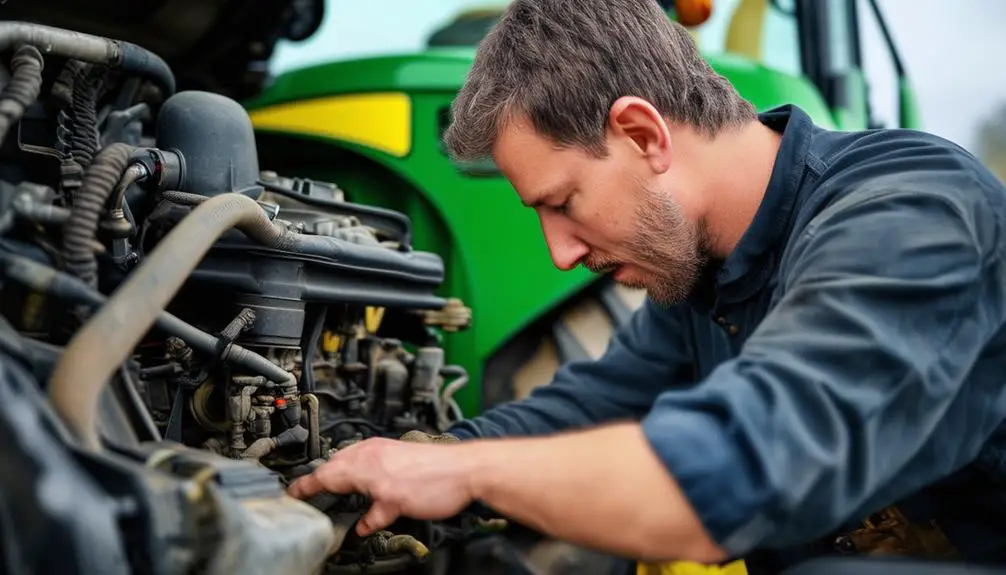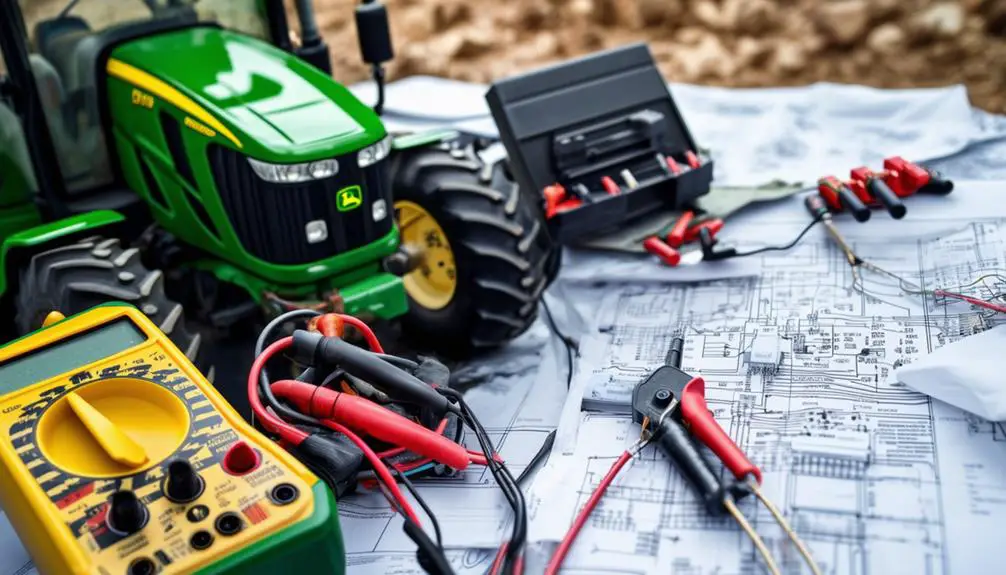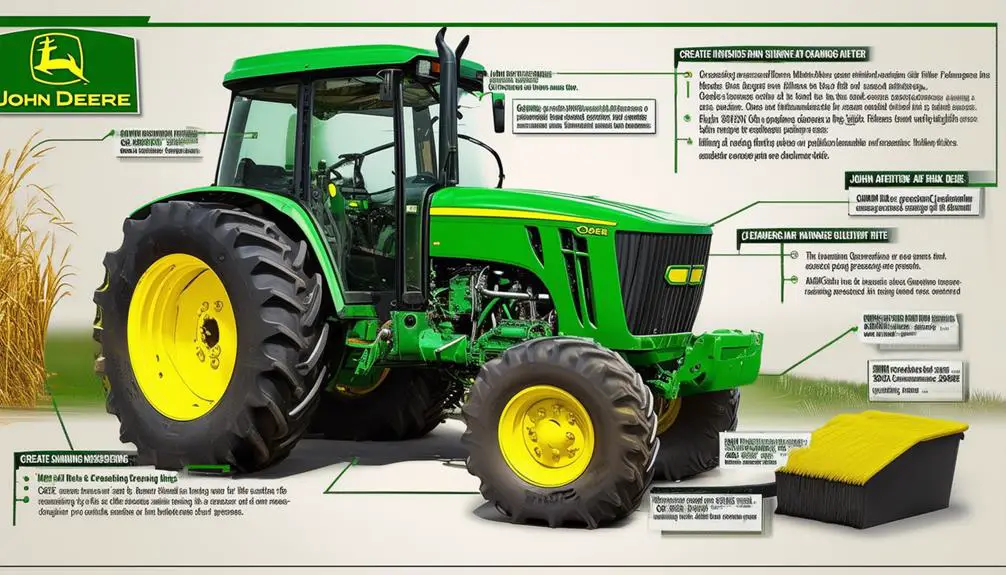When exploring the domain of John Deere 3038E problems, it's akin to taming a complex mechanical beast with finesse. The key lies in unraveling the mystery of the top five solutions that could potentially transform your troubleshooting journey. From unraveling engine intricacies to deciphering electrical system enigmas, each solution holds a critical piece of the puzzle. So, buckle up, for an insightful exploration awaits, guiding you through the maze of tractor tribulations.
Things to Note
- Check fuel filter for clogs and replace if necessary to maintain engine performance.
- Inspect hydraulic fluid levels regularly to prevent loss of power and damage.
- Ensure tight battery connections and test voltage to troubleshoot electrical issues.
- Monitor transmission fluid levels, address leaks, and investigate shifting problems promptly.
- Adhere to manufacturer's maintenance schedule for consistent upkeep and prevent major problems.
Engine Troubleshooting Tips

If your John Deere 3038E is experiencing engine issues, start by checking the fuel filter for any clogs. A clogged fuel filter can restrict the flow of fuel to the engine, leading to performance issues. To address this, locate the fuel filter, typically found near the fuel pump, and inspect it for any debris or blockages. If clogged, replace the filter with a new one to ensure proper fuel flow and peak engine performance.
Next, examine the spark plugs for signs of wear or damage. Worn-out spark plugs can result in misfiring or difficulty starting the engine. Remove the spark plugs carefully, inspect them for any abnormalities such as carbon deposits or erosion, and replace if necessary. This simple maintenance task can help your engine run smoothly and effectively.
Hydraulic System Maintenance Guide
To maximize performance and longevity of your John Deere 3038E, proper maintenance of the hydraulic system is essential. Keeping your hydraulic system in top condition ensures smooth operation and prevents costly breakdowns. Here are essential maintenance tips for your hydraulic system:
| Maintenance Task | Frequency | Significance |
|---|---|---|
| Check hydraulic fluid levels | Every 50 hours | Maintains proper lubrication and cooling of system |
| Inspect for leaks | Monthly | Prevents loss of hydraulic power and potential damage |
| Replace hydraulic filters | Every 200 hours | Keeps the system clean and maintains peak performance |
Regularly checking fluid levels, inspecting for leaks, and replacing filters as recommended are simple yet effective ways to care for your John Deere 3038E's hydraulic system. By staying on top of these maintenance tasks, you can enjoy uninterrupted operation and extend the life of your equipment.
Electrical System Problem Solving

Effective troubleshooting of electrical system issues on your John Deere 3038E requires a systematic approach and attention to detail. When facing electrical problems, start by checking the battery connections for tightness and corrosion. Loose or corroded connections can disrupt the flow of electricity and cause malfunctions.
Inspect the wiring harness for any signs of damage or wear, as frayed wires can lead to short circuits or loss of power. Utilize a multimeter to test the voltage output of the battery and confirm it's within the recommended range.
If the battery and wiring are in good condition, proceed to examine the fuses and relays. A blown fuse or faulty relay can interrupt the electrical circuit and prevent proper functioning.
Transmission Issues: Fixes and Prevention
Check the transmission fluid levels regularly to prevent and address potential issues with your John Deere 3038E. Low transmission fluid can lead to poor performance and even damage to the transmission system. If you notice any leaks, address them promptly to avoid more significant problems down the line.
In case you experience rough shifting or unusual noises during gear changes, it could indicate issues with the transmission that require immediate attention.
To fix transmission problems on your John Deere 3038E, start by checking for any error codes using diagnostic tools. If you're comfortable doing so, inspect the transmission filter and fluid for any signs of contamination or wear. Replacing these components at recommended intervals can help prevent costly repairs in the future.
Additionally, make sure that the transmission is properly calibrated and adjusted according to the manufacturer's specifications.
Regularly servicing your transmission by following the manufacturer's maintenance schedule is vital for preventing transmission issues on your John Deere 3038E. By staying proactive and addressing any potential problems promptly, you can keep your tractor running smoothly and efficiently.
Implementing Regular Maintenance Practices

Maintain your John Deere 3038E in top condition by consistently performing scheduled upkeep tasks. Regular maintenance is key to preventing future issues and guaranteeing your tractor operates smoothly.
Start by adhering to the manufacturer's upkeep schedule, which includes oil changes, filter replacements, and fluid checks. Keep an eye on the tire pressure, as improper inflation can affect performance. Inspect the battery regularly for any signs of corrosion or damage.
Clean the exterior of your tractor to prevent dirt buildup, especially around the engine and radiator. Additionally, greasing the fittings and inspecting the belts for wear are essential tasks to keep your John Deere 3038E running efficiently.
Frequently Asked Questions
How Can I Enhance the Comfort of My John Deere 3038E Tractor?
To enhance the comfort of your John Deere 3038E tractor, consider adding a cushioned seat cover. Installing ergonomic armrests and adjusting the seat position for maximum comfort are also beneficial upgrades. Additionally, investing in vibration-dampening floor mats and noise-reducing insulation can further improve your overall experience while operating the tractor.
These simple upgrades can make a big difference in how comfortable you feel during those long hours in the field.
Are There Any Common Accessories to Improve the Functionality of the Tractor?
Looking to boost your John Deere 3038E's functionality? Common accessories like loaders, backhoes, and canopy tops can enhance your tractor's capabilities.
These additions provide versatility, protection from the elements, and increased productivity. Consider outfitting your machine with these accessories for a more efficient and comfortable working experience.
Explore the possibilities and transform your tractor into a powerhouse on the field.
What Are Some Recommended Tire Maintenance Tips for the John Deere 3038e?
To keep your John Deere 3038E running smoothly, make sure to check tire pressure regularly. Proper inflation helps prevent uneven wear and improves traction.
Inspect tires for any signs of damage or wear, and rotate them as recommended by the manufacturer to promote even tread wear.
Lastly, make sure tires are properly aligned to prevent unnecessary strain on the tractor.
Following these maintenance tips will help maximize the lifespan of your tires.
Can I Use Alternative Fuels in My John Deere 3038E Without Causing Damage?
You're in the driver's seat wondering about fuel choices for your John Deere 3038E. Let's rev things up!
While it's always best to stick to what the manufacturer recommends, you can explore some alternative fuel options. Just keep an eye out for any potential negative impacts on your equipment.
Time to fuel your curiosity and explore new possibilities while staying mindful of your machine's needs.
What Are the Best Practices for Storing the John Deere 3038E During Off-Seasons?
When storing your John Deere 3038E during off-seasons, it is important to take certain precautions to ensure its longevity and performance. Keep it in a dry, covered area to prevent rust and damage. Store it with a full tank of fuel and add a fuel stabilizer to prevent fuel degradation.
Remove the battery from the tractor and store it in a cool, dry place to prolong its lifespan. Consider using a trickle charger to maintain the battery's charge and prevent it from losing power over time.
Before storing your John Deere 3038E, perform any recommended maintenance tasks to address any issues and ensure that it is in top condition for its next use. This proactive approach will help you avoid any last-minute problems and ensure that your tractor is ready to go when you need it next.
Conclusion
To wrap up, by following these five solutions for John Deere 3038E problems, you can keep your tractor running smoothly and efficiently.
Remember, 'an ounce of prevention is worth a pound of cure.'
Stay proactive in maintaining your equipment to avoid costly repairs and downtime.
Happy farming!